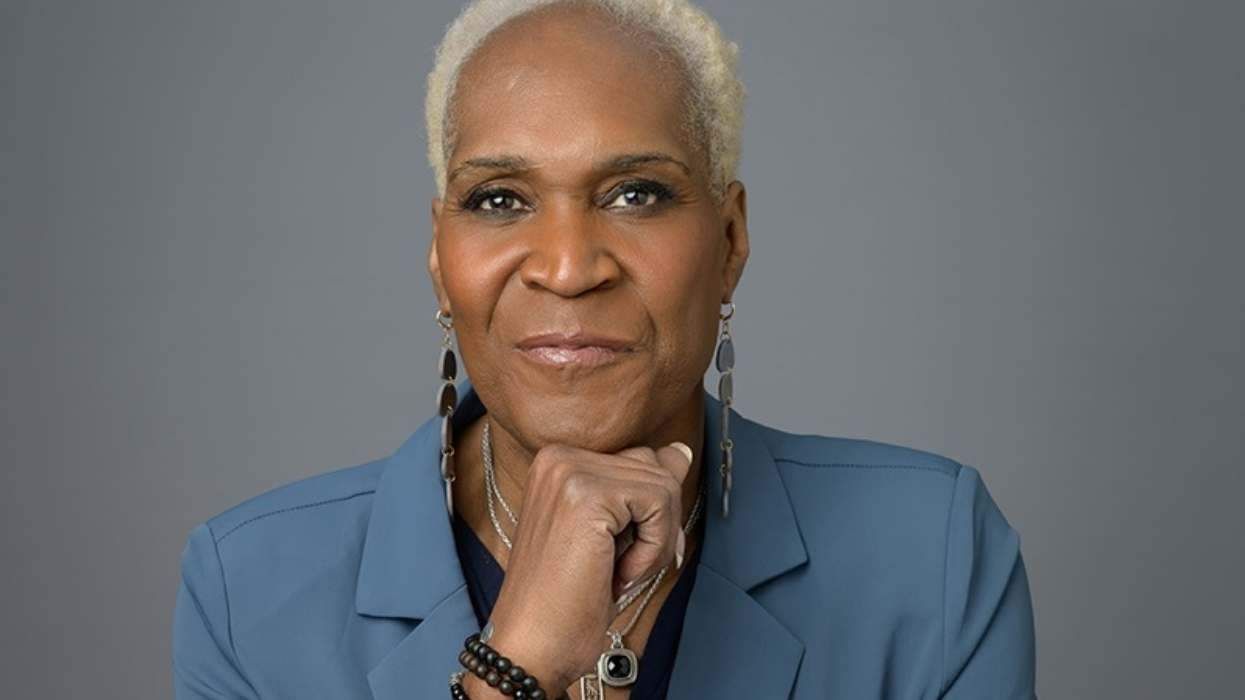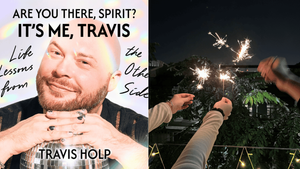
CONTACTAbout UsCAREER OPPORTUNITIESADVERTISE WITH USPRIVACY POLICYPRIVACY PREFERENCESTERMS OF USELEGAL NOTICE
© 2026 Equal Entertainment LLC.
All Rights reserved
All Rights reserved
By continuing to use our site, you agree to our Privacy Policy and Terms of Use.
We need your help
Your support makes The Advocate's original LGBTQ+ reporting possible. Become a member today to help us continue this work.
Your support makes The Advocate's original LGBTQ+ reporting possible. Become a member today to help us continue this work.
The religious landscape of California is diverse and populated with communities of people who have often been shunned by their more traditional religions. Rick Nahmias attempts to give them a presence with his photo documentary.
Golden States of Grace: Prayers of the Disinherited, a preface by Rick Nahmias
I am of the firm belief that every one of us carries something within that is marginalized: some piece of personal history or trait that has been, or which we wish would be left behind or cast off -- the emotional scars left by an abusive alcoholic mother, the malformed foot, the embarrassingly immigrant heritage and so forth. It is this concept (compounded by an allegiance to Jung's theory of the Collective Unconscious) which has led me to conclude that those whom society has cast off as "them" are, in reality, "us," and which drove the creation of this body of work.
Since I began "Golden States of Grace" in 2003, it has often felt as if our world has drawn increasingly more stark divisions between "us" and "them," be those divides cultural, political, socio-economic, or religious. Additionally, representations across faith lines have become filled with stereotypes, and at times, the outright hatred of the other. National and international events demonstrate almost daily that we live in a fundamentally faith-based society which has grown increasingly intolerant of those who do not clearly embrace the narrowly defined codes of morality and religious worship. (The day before I began editing this book a man with a gun entered a church in Knoxville, Tennessee, shot eight people, killing two. His motive: they were too liberal in that they supported the inclusion of gays, racial desegregation, and women's rights.) This body of work aims specifically to counteract that intolerance, hoping its audience might open itself to discovering (if not experiencing) faith from the bottom up.
Even with the prevalence of mainline religious institutions and middle-class America continuing to exclude and even vilify those they view as "beyond the pale," there are still reasons to be hopeful that we, as a society, can see beyond our religious tunnel vision. A recent study on religious views across America published by The Pew Forum on Religion and Public Life documented that nearly three-quarters of Americans believe that many faiths beyond their own can lead to salvation.
You do not have to want to sit down to breakfast with someone to respect his or her place beside you in sanctuary or in community. Nor is not my intention that this book's reader throw their arms open to embrace the people depicted within it. Rather, if I have one singular hope, it is that our collective eyes remain open long enough to simply acknowledge every human being's need and right to come to some profound understanding about their own connection to a higher power.
Thus, in the end, "Golden States of Grace" is a study of otherness -- the otherness out there, the otherness within each of us, the otherness which begs us to bind together as human beings to celebrate, contemplate, and find meaning in our lives.
Participating Communities
(listed in order of documentation)
* Beit T'Shuvah (Culver City): Having opened its doors in 1987, this is the nation's only halfway house aiding addicts self-identified as Jewish. All residents participate in 12-step recovery which is interwoven with Torah study. Beit T'Shuvah's 115-bed facility works with 170 alcohol, drug, sex, and gambling addicts a year. Its leaders and residents were documented over Passover and Yom Kippur observances.
* Transcendence (San Francisco): The world's only transgender gospel choir, Transcendence, founded in 2001, provides both a second family for many of its nearly 20 members and a safe environment for them to adjust to their new voices while in transition from hormone treatment. Performing dozens of concerts annually, they were photographed rehearsing and performing for a San Francisco-based arts festival. -- Included in this portfolio
* Buddhadharma Sangha at San Quentin Prison (San Quentin): This group of Zen Buddhist practitioners is composed of men incarcerated in California's oldest prison. Led by a Zen master from Marin County, they meet every Sunday for several hours, engaging in meditation, chanting, and formal Dharma discussions aimed at allowing inmates to reflect on their pasts as well as their futures.
* Sex workers devoted to Santisima Muerte (San Francisco):
This community of Latina sex workers, who have mostly immigrated from Guadalajara, Mexico, embraces the female folk deity Santisima Muerte, among other patron saints such as St. Jude and the Virgin of Guadalupe. Santisima Muerte (directly translated as Holy Death and personified by a cloaked skeleton) is believed to have been sent to rescue the "lost" or outcast in society and safeguard them from harm. They were documented over several days at their single-room occupancy hotels in San Francisco's Tenderloin. -- Included in this portfolio
* Immaculate Heart Community (Santa Barbara):
Composed originally of dispensated Catholic nuns with a median age over 70, this community broke from the Los Angeles archdiocese in 1970 after its members decided to pursue a doctrine focusing on social justice, holding strong feminist tenets, and advocating for the marginalized. Exiting their ranks as nuns, they left behind the safety net of jobs, homes, and pensions. IHC membership is open to men and women, single or married, from all Christian denominations, and members come from many fields, including education, social work, and law. They were documented during their statewide retreat at Casa de Maria in the hills of Santa Barbara.
* Rurally Isolated Pentecostals & Baptists (San Joaquin Valley):
This mostly African-American Christian community hails from across the Central Valley, but many of its members travel upward of 60 miles to worship in one of three small churches in the unincorporated towns of Teviston and Pixley, located in Tulare County, one of California's most impoverished counties. Many congregants were born into families who picked cotton or performed other farm labor even after moving on to places like Bakersfield or Fresno, and several of them still choose to return weekly to keep these tiny churches alive through prayer and community outreach.
* Federated Indians of The Graton Rancheria (Santa Rosa):
This tribe consists of both Coast Miwok and Southern Pomo Native Americans whose ancestors have existed in this region for thousands of years, with territorial lands, which included all of Marin and southern Sonoma counties. Having received official recognition by Congress in 2000, in the past few years they have begun reclaiming their ancient rituals, dances, and language. They allowed their annual Acorn Festival to be recorded for the first time for this project.
* Cham Muslims (Santa Ana):
The Cham, a distinct cultural minority because of their language and Muslim faith, were specifically targeted for annihilation when the genocide of the Khmer Rouge regime began in Cambodia in 1975. Of the approximately 250,000 Cham, roughly 36%, or ninety thousand people, were murdered or starved to death by 1979. Fifteen of the surviving families settled in Orange County in 1980, eventually bringing over other families one at a time to a small apartment complex which would soon house them, a mosque, and their Sunday school. They were photographed at the close of the Islamic holy month of Ramadan during the feast of Eid ul-Fitr.
* Women of Wisdom at California Institute for Women (Chino-Corona):
This is an "inside/outside" spirituality group for female prison inmates and the women from the outside who join them in forming a faith community. The circle is inter-faith and multicultural as dictated by the women in prison themselves. The group is composed of approximately ten women from the "outside" and thirty women on the "inside" who participate in a monthly evening of dialogue, ritual, and listening to the Spirit within and among them.
* Deaf Members of the University City Branch of the Church of Latter-Day Saints (San Diego):
Started in 1990, this Branch of the Mormon Church caters especially to deaf as well as some blind church members. With a number of service projects, in-house visits, sacrament meetings, and even musical stage performances, this Branch has dozens of members, and was formed out of a desire for hearing-impaired individuals to take part in spiritual devotion and community events which would not be compromised due to their disability.
* People with HIV/AIDS at Kashi Ashram (West Hollywood):
Though open to people of all faiths, the Ashram uses a combination of Hindu sacred practices and traditions including yoga and meditation to reach its members, many of whom are HIV+ or battling AIDS. Founded by Guru Ma Jaya and her chelas (students), a large part of their spiritual and practical focus since the community was first formed in 1976 has been around issues of death and dying as well as performing service to disenfranchised people, especially the poor and those facing life-challenging illnesses. -- Included in this portfolio Rick Nahmias is a photographer, writer, and visual storyteller whose work has been shown across North America, Europe, and Asia. He creates social issue-themed media projects for foundations, nonprofits, corporations, and cause-driven organizations.
Golden States of Grace: Prayers of the Disinherited was recently published by University of New Mexico Press. His body of work exploring California's agricultural workforce, The Migrant Project: Contemporary California Farm Workers, was also published by UNM Press and chosen by Grist.org as a favorite book of 2010. The companion exhibitions of his books have toured to over four dozen museums, universities, and cultural centers across the country.
His images and writing have been profiled and published in national newspapers, journals, blogs, and newsweeklies such as Newsweek, the Los Angeles Times, The Washington Post, The Huffington Post, and Gastronomica. His work has been presented on the floor of the U.S. House of Representatives, is part of the permanent collection of the National Museum of American History at the Smithsonian, and resides in several private and public collections across the country.
His work has been funded by the Durfee Foundation, the Columbia Foundation, and the Pew Charitable Trusts, among others. He was an invited speaker at the 2011 TEDx Conference in Los Angeles, where shared his innovative combination of visual storytelling and activism. He is founder and executive director of the award-winning antihunger nonprofit Food Forward and is a graduate of New York University.
xtyfr
From our Sponsors
Most Popular
Bizarre Epstein files reference to Trump, Putin, and oral sex with ‘Bubba’ draws scrutiny in Congress
November 14 2025 4:08 PM
True
Jeffrey Epstein’s brother says the ‘Bubba’ mentioned in Trump oral sex email is not Bill Clinton
November 16 2025 9:15 AM
True
Watch Now: Pride Today
Latest Stories
Kazakhstan bans so-called LGBTQ+ propaganda
December 30 2025 3:24 PM
Trump administration bans abortions through Department of Veterans Affairs
December 30 2025 11:07 AM
Zohran Mamdani: Save a horse, play a yet-unreleased Kim Petras album
December 30 2025 10:29 AM
How No Kings aims to build 'protest muscle' for the long term
December 30 2025 7:00 AM
Missing Black trans man Danny Siplin found dead in Rochester, New York
December 29 2025 8:45 PM
'Heated Rivalry' season 2: every steamy & romantic moment from the book we can't wait to see
December 29 2025 5:27 PM
Chappell Roan apologizes for praising late Brigitte Bardot: 'very disappointing'
December 29 2025 4:30 PM
RFK Jr.'s HHS investigates Seattle Children's Hospital over youth gender-affirming care
December 29 2025 1:00 PM
Zohran Mamdani claps back after Elon Musk attacks out lesbian FDNY commissioner appointee
December 29 2025 11:42 AM
Trump's gay Kennedy Center president demands $1M from performer who canceled Christmas Eve show
December 29 2025 10:09 AM
What does 2026 have in store for queer folks? Here’s what's written in the stars
December 29 2025 9:00 AM
In 2025, being trans in America means living under conditional citizenship
December 29 2025 6:00 AM
Here are the best shows on and off-Broadway of 2025
December 26 2025 7:00 AM
Trending stories
Recommended Stories for You
Christopher Harrity
Christopher Harrity is the Manager of Online Production for Here Media, parent company to The Advocate and Out. He enjoys assembling online features on artists and photographers, and you can often find him poring over the mouldering archives of the magazines.
Christopher Harrity is the Manager of Online Production for Here Media, parent company to The Advocate and Out. He enjoys assembling online features on artists and photographers, and you can often find him poring over the mouldering archives of the magazines.



































































Charlie Kirk DID say stoning gay people was the 'perfect law' — and these other heinous quotes